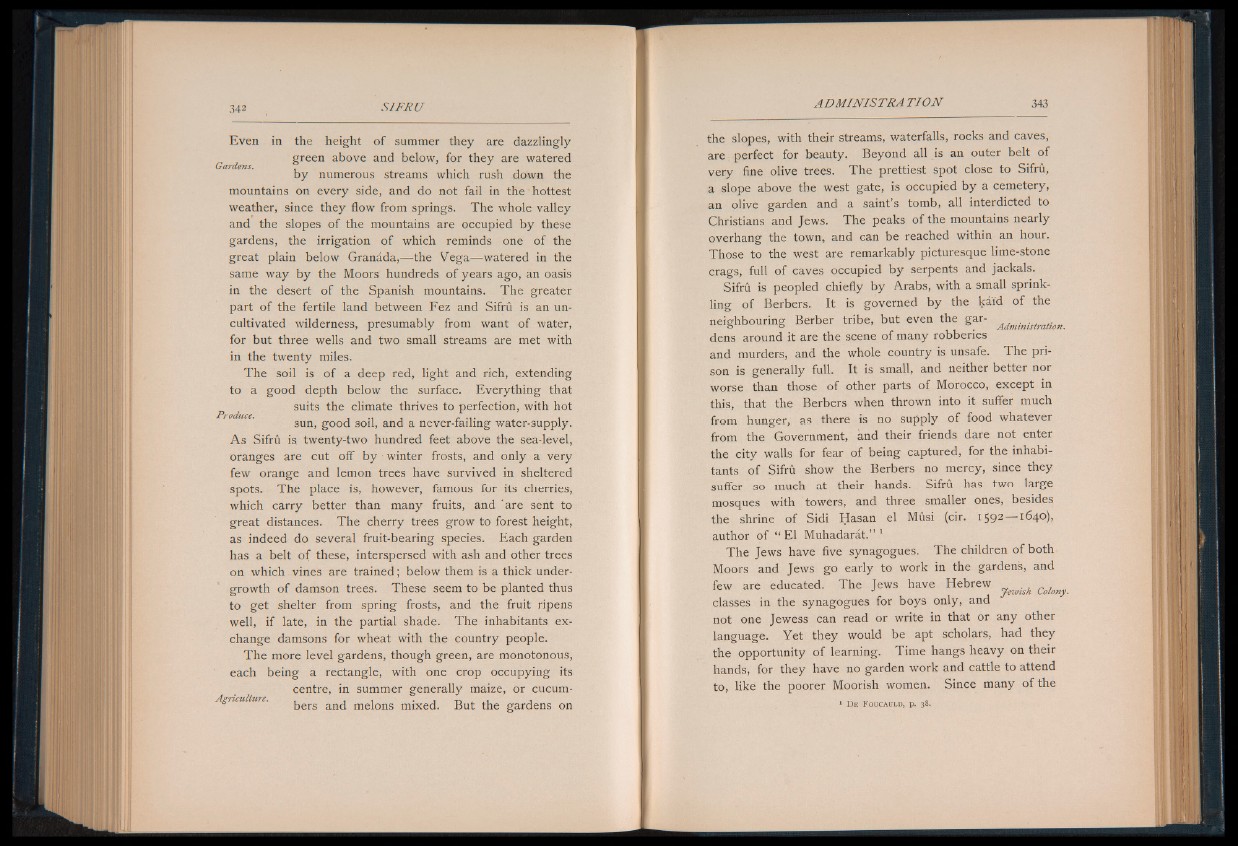
Even in the height of summer they are dazzlingly
green above and below, for they are watered
Gardens.
by numerous streams which rush down the
mountains on every side, and do not fail in the hottest
weather, since they flow from springs. The whole valley
and the slopes of the mountains are occupied by these
gardens, the irrigation of which reminds one of thè
great plain below Granada,— the Vega— watered in the
same way by the Moors hundreds of years ago, an oasis
in the desert of the Spanish mountains. The greater
part of the fertile land between Fez and Sifru is an uncultivated
wilderness, presumably from want of water,
for but three wells and two small streams are met with
in the twenty miles.
The soil is of a deep red, light and rich, extending
to a good depth below the surface. Everything that
p j suits the climate thrives to perfection, with hot
sun, good soil, and a never-failing water-supply.
A s Sifru is twenty-two hundred feet above the sea-level,
oranges are cut off by winter frosts, and only a very
few orange and lemon trees have survived in sheltered
spots. The place is, however, famous for its cherries,
which carry better than many fruits, and are sent to
great distances. The cherry trees grow to forest height,
as indeed do several fruit-bearing species. Each garden
has a belt o f these, interspersed with ash and other trees
on which vines are trained ; below them is a thick undergrowth
of damson trees. These seem to be planted thus
to get shelter from spring frosts, and the fruit ripens
well, if late, in the partial shade. The inhabitants exchange
damsons for wheat with the country people.
The more level gardens, though green, are monotonous,
each being a rectangle, with one crop occupying its
centre, in summer generally maize, or cucumbers
and melons mixed. But the gardens on
the slopes, with their streams, waterfalls, rocks and caves,
are perfect for beauty. Beyond all is an outer belt of
very fine olive trees. The prettiest spot close to Sifru,
a slope above the west gate, is occupied by a cemetery,
an olive garden and a saint’s tomb, all interdicted to
Christians and Jews. The peaks of the mountains nearly
overhang the town, and can be reached within an hour.
Those to the west are remarkably picturesque lime-stone
crags, full of caves occupied by serpents and jackals.
Sifru is peopled chiefly by Arabs, with a small sprinkling
of Berbers. It is governed by the kai'd of the
neighbouring Berber tribe, but even the gar- AdminUtraiion_
dens around it are the scene of many robberies
and murders, and the whole country is unsafe. The prison
is generally full. It is small, and neither better nor
worse than those of other parts of Morocco, except in
this, that the Berbers when thrown into it suffer much
from hunger, as there is no supply o f food whatever
from the Government, and their friends dare not enter
the city walls for fear of being captured, for the inhabitants
of Sifru show the Berbers no mercy, since they
suffer so much at their hands. Sifru has two large
mosques with towers, and three smaller ones, besides
the shrine of Sidi Hasan el Musi (cir. 1 592 —
author of “ El Muhadarat.” 1
The Jews have five synagogues. The children of both
Moors and Jews go early to work in the gardens, and
few are educated. The Jews have Hebrew ^ ^
classes in the synagogues for boys only, and
not one Jewess can read or write in that or any other
language. Yet they would be apt scholars, had they
the opportunity of learning. Time hangs heavy on their
hands, for they have no garden work and cattle to attend
to, like the poorer Moorish women. Since many of the
1 D e F o u c a u l d , p . 38.